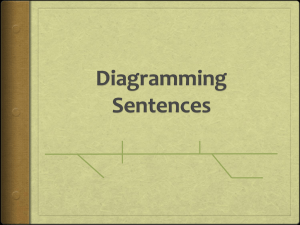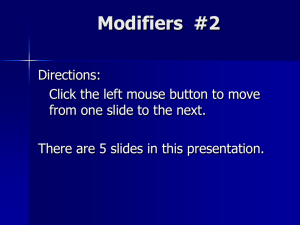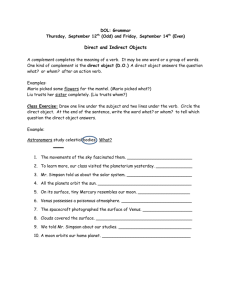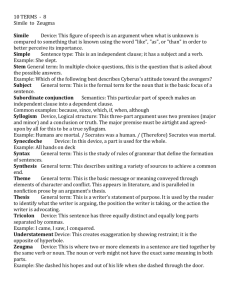sample questions
advertisement
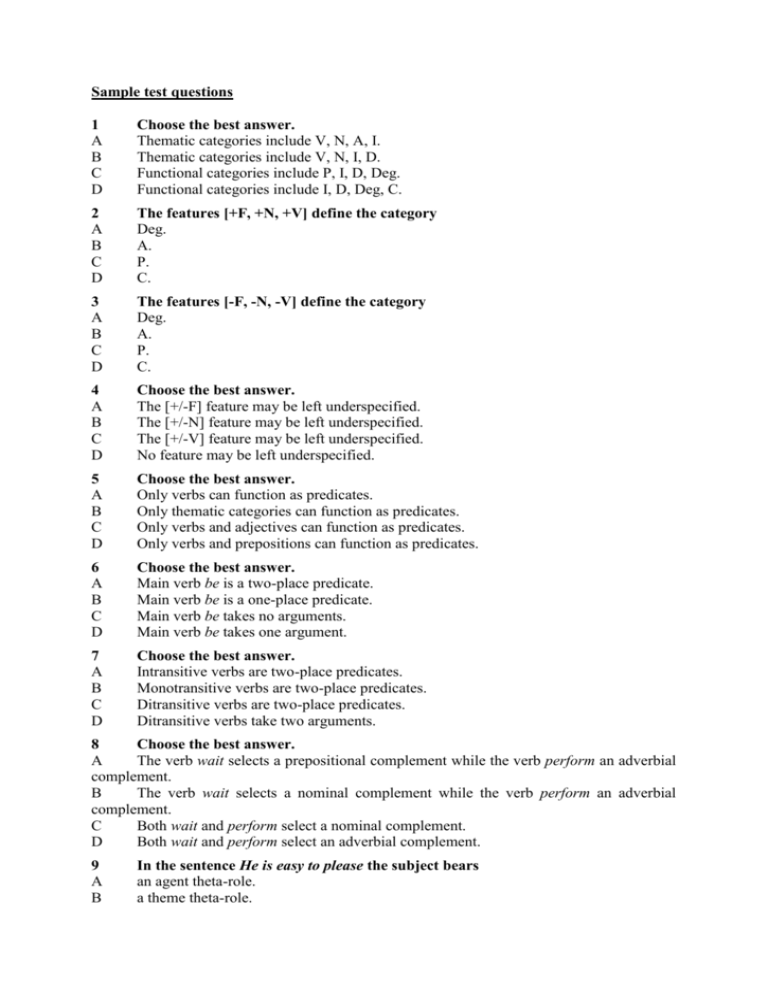
Sample test questions 1 A B C D Choose the best answer. Thematic categories include V, N, A, I. Thematic categories include V, N, I, D. Functional categories include P, I, D, Deg. Functional categories include I, D, Deg, C. 2 A B C D The features [+F, +N, +V] define the category Deg. A. P. C. 3 A B C D The features [-F, -N, -V] define the category Deg. A. P. C. 4 A B C D Choose the best answer. The [+/-F] feature may be left underspecified. The [+/-N] feature may be left underspecified. The [+/-V] feature may be left underspecified. No feature may be left underspecified. 5 A B C D Choose the best answer. Only verbs can function as predicates. Only thematic categories can function as predicates. Only verbs and adjectives can function as predicates. Only verbs and prepositions can function as predicates. 6 A B C D Choose the best answer. Main verb be is a two-place predicate. Main verb be is a one-place predicate. Main verb be takes no arguments. Main verb be takes one argument. 7 A B C D Choose the best answer. Intransitive verbs are two-place predicates. Monotransitive verbs are two-place predicates. Ditransitive verbs are two-place predicates. Ditransitive verbs take two arguments. 8 Choose the best answer. A The verb wait selects a prepositional complement while the verb perform an adverbial complement. B The verb wait selects a nominal complement while the verb perform an adverbial complement. C Both wait and perform select a nominal complement. D Both wait and perform select an adverbial complement. 9 A B In the sentence He is easy to please the subject bears an agent theta-role. a theme theta-role. C D an experiencer theta-role. a goal theta-role. 10 Given the following sentences, (i) She saw that he left; (ii) For him to leave wasn’t easy; (iii) She wondered whether he left; choose the best answer. A Sentence (i) and (ii) contain a non-finite clause. B Sentence (i) and (iii) contain a finite-clause. C Sentence (ii) and (iii) contain a non-finite clause. D Sentence (ii) and (iii) contain a finite clause. 11 A B C D Which of the following statements is false? Sentences can contain clauses. Phrases can contain clauses. Phrases cannot contain phrases. Words cannot contain phrases. 12 A B C D Which of the following sentences contains an expletive (pleonastic) subject? He took it for granted that he would get the money. It was too heavy to lift. It surprised everyone that he left. He had a hard time of it in the army. 13 A B C D In the sentence Their grandmother told the children a bedtime story, the indirect object is a bedtime story. the direct object is a bedtime story. the direct object is the children. the indirect object is left implicit. 14 A B C D Which of the following statements is false? Phrases can adjoin to phrases. Heads can adjoin to phrases. Heads can adjoin to heads. Phrases can adjoin to intermediate constituents. 15 A B C D The sentence Peter, Mary never liked exemplifies extraposition. passivisation. preposing. topicalisation. 16 A B C D The sentence It surprised us that he left exemplifies extraposition. passivisation. preposing. topicalisation. 17 A B C D The sentence Yesterday they went to the zoo exemplifies extraposition. passivisation. preposing. topicalisation. 18 According to the UTAH, A theta-roles are assigned to the same structural position in all structures where they are present. B theta-roles are assigned at S-structure. C one argument gets only one theta-role and one theta-role can be assigned to only one argument. D theta-roles are assigned at D-structure. 19 A B C D Choose the best answer. Substitution creates a new position by movement. Adjunction creates a new position by movement. The landing site contains the foot of a chain created by movement. The landing site contains the trace left by a moved element. 20 A B C D The matrix clause in the sentence It appears that the flowers were stolen contains an expletive subject and an unaccusative verb. an implicit subject and an intransitive verb. an agent subject and an unaccusative verb. an expletive subject and a raising verb. 21 A B C D The sentence The man living next door knew that the neighbours left contains a DP subject and a DP object. a clausal subject and an object clause. a clausal subject and a DP object. a DP subject and an object clause. 22 A B C D In the sentence That he left when she arrived surprised the people who were present the object contains a DP complement. the subject contains an adjunct clause. the adjunct contains a DP complement. the predicate contains an adjunct clause. 23 A B C D Choose the best answer. Predeterminers and central determiners are generated under the D head node. Central determiners and postdeterminers are generated under the D head node. Predeterminers are generated in [Spec, DP] and central determiners are generated in D. Central determiners are generated in [Spec, DP] and postdeterminers in D. 24 A B C D Choose the best answer. In English, morphological case is visible on nouns and pronouns. In English, abstract case is visible on nouns and pronouns. In English, morphological case is visible on pronouns. In English, abstract case is visible on nouns. 25 A B C D The DP the *student of Physics and in jeans is ungrammatical because two PPs are coordinated. two adjuncts are coordinated. two complements are coordinated. a complement and an adjunct are coordinated. 26 (i) Given the tree diagram in (i), choose the best answer. X’ Y’ A X’ X The labeled bracketed representation of (i) is [X’ X’ Y’]. B C D (i) is a tree diagram corresponding to one of the instantiations of the adjunct rule. (i) is not a legitimate tree, i.e. it is not allowed by the three general rewrite rules. The labeled bracketed representation of (i) is [X’ [Y’X] X’]. 27 A B C D According to the Case Filter every overt DP must have case. every NP must have case. every DP and clause with a nominal function must have case. every NP and clause in a nominal position must have case. 28 A B C D The sentence It was Mary that left exemplifies pseudo-clefting. exemplifies clefting. is ungrammatical. contains a clausal object. 29 The sequence *Peter loves Mary John, where Mary and John are distinct participants, is ruled out by A the Case Filter. B the UTAH. C the Locality Restriction on Theta Role assignment. D The Theta Criterion. 30 In the sentence The people in the room seemed to be reluctant to be involved in answering the question, the subject is the argument of, i.e. is theta-marked by, A involved. B seemed. C answering. D reluctant. Please note that the above questions exemplify types or formats, not the actual exam questions, and that these serve as a general guide to approaching a syntax multiple choice test.
